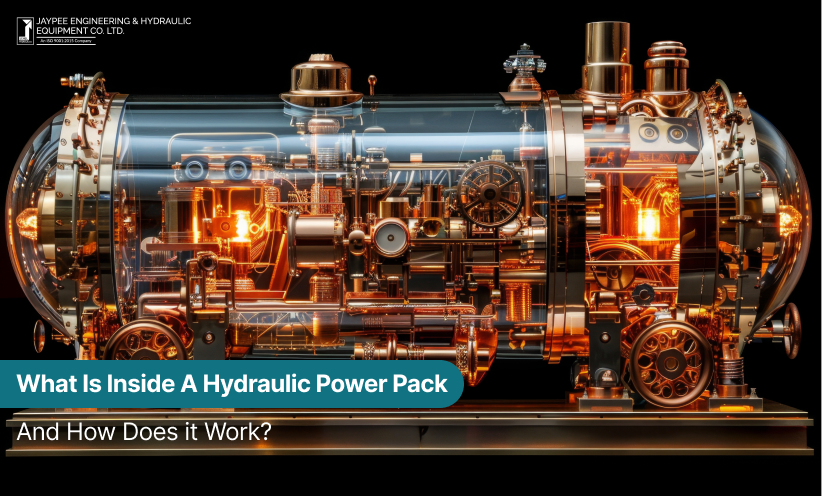A hydraulic power pack is a vital component of many machinery and industrial systems. It plays a crucial role in facilitating the conversion of mechanical energy into hydraulic energy, making it possible to operate various hydraulic systems. Understanding the basic principles and components of a hydraulic power pack is essential for anyone working with or around these powerful machines.
Understanding the Basics of a Hydraulic Power Pack
Definition and Function of a Hydraulic Power Pack
Before diving into the inner workings of a hydraulic power pack, it’s important to understand what it is and how it functions. A hydraulic power pack, also known as a hydraulic power unit, is a self-contained system that generates hydraulic energy using an electric motor or an internal combustion engine. It is designed to supply hydraulic fluid at controlled pressures and flow rates to drive hydraulic actuators and perform various tasks.
Imagine a construction site bustling with activity. Workers are using heavy machinery to lift and move massive loads effortlessly. How is this possible? The answer lies in the hydraulic power pack, silently working behind the scenes, providing the necessary power to make these tasks seem effortless.
Key Components of a Hydraulic Power Pack
A hydraulic power pack consists of several essential components that work together to create a functional hydraulic system. These components include:
- Electric Motor or Internal Combustion Engine: This serves as the power source for the hydraulic power pack. It converts electrical or mechanical energy into rotational motion, which drives the hydraulic pump.
- Hydraulic Pump: The pump is the heart of the hydraulic power pack. It draws fluid from the reservoir and pressurizes it, allowing it to move through the system and power the hydraulic actuators. Just like a human heart pumps blood to all parts of the body, the hydraulic pump ensures the smooth flow of hydraulic fluid to all the components of the system.
- Reservoir: The reservoir acts as a vital organ, storing the hydraulic fluid. It not only provides a constant supply of fluid but also acts as a buffer to maintain the fluid’s temperature and remove any air or contaminants that may be present. Think of it as a well-nourished stomach, always ready to provide the necessary sustenance to keep the hydraulic system running smoothly.
- Control Valves: These valves are like the skilled conductors of an orchestra, regulating the flow and pressure of the hydraulic fluid. They direct the fluid to different actuators and control the speed and direction of movement. Just as a conductor brings harmony to a musical composition, control valves bring precision and control to the hydraulic system.
- Hydraulic Actuators: Actuators are the muscles of the hydraulic system, responsible for converting hydraulic energy into mechanical energy to perform physical work. They can be hydraulic cylinders, motors, or hydraulic-powered tools. Picture a strong and agile athlete, effortlessly lifting heavy weights or performing complex movements. That’s the power of hydraulic actuators in action.
- Filters and Coolers: Filters act as the system’s guardians, removing contaminants from the hydraulic fluid. Just as our body’s immune system fights off harmful invaders, filters ensure that the hydraulic fluid remains clean and free from particles that could potentially damage the system. Coolers, on the other hand, are like the system’s air conditioning, regulating the fluid’s temperature, preventing overheating, and ensuring optimum performance even in the most demanding conditions.
- Pressure Relief Valve: This safety valve is the guardian angel of the hydraulic system, protecting it from excessive pressure. Just as a safety valve releases excess steam from a pressure cooker, the pressure relief valve diverts excess fluid back to the reservoir, preventing any catastrophic failures and ensuring the system’s longevity.
Now that we have explored the key components of a hydraulic power pack, let’s take a closer look at how they work together in perfect harmony to create a powerful and efficient hydraulic system.
The Inner Workings of a Hydraulic Power Pack
The Role of Hydraulic Fluid
Hydraulic fluid is a vital component in a hydraulic power pack. It serves multiple functions, including transmitting power, lubricating moving parts, and dissipating heat. The fluid is typically a specially formulated oil, chosen for its excellent lubricating properties, anti-wear additives, and resistance to degradation under high-pressure conditions.
Furthermore, the hydraulic fluid plays a crucial role in maintaining the cleanliness of the system. It contains additives that help prevent the formation of sludge, varnish, and other contaminants that could potentially clog the hydraulic lines or damage the components. Regular monitoring and maintenance of the fluid quality are essential to ensure the proper functioning and longevity of the hydraulic power pack.
When the hydraulic power pack is operating, the pump draws fluid from the reservoir and delivers it under high pressure to the hydraulic actuators. As the fluid moves through the system, it transfers energy to the actuators, causing them to extend or retract, thereby generating mechanical movement.
The Importance of Pressure in Hydraulic Systems
Pressure is a critical aspect of hydraulic systems. It determines the force that can be exerted by the actuators and affects the system’s overall performance. The hydraulic power pack maintains the required pressure levels by regulating the flow of hydraulic fluid and adjusting the settings of the control valves. This allows for precise control of the hydraulic actuators and ensures smooth and efficient operation.
Moreover, pressure control is essential for safety in hydraulic systems. Excessive pressure can lead to component failure or system malfunctions, posing risks to equipment and operators. Pressure relief valves are incorporated into hydraulic power packs to prevent overpressurization and safeguard the system from potential damage. These valves are designed to open at a predetermined pressure threshold, diverting excess fluid back to the reservoir and maintaining the system within safe operating limits.
The Operation Process of a Hydraulic Power Pack
Starting Up and Shutting Down a Hydraulic Power Pack
Proper procedures should be followed when starting up or shutting down a hydraulic power pack to ensure safe and efficient operation. When starting, it is important to check all fluid levels, inspect for any leaks or damage, and ensure that all control valves are in their neutral positions. Once everything is confirmed, the power pack can be powered on and the hydraulic system can be activated gradually to prevent sudden pressure surges.
During shutdown, it is important to first release pressure from the system by activating the pressure relief valve. Then, the control valves should be returned to their neutral positions, and the power pack can be safely turned off.
Maintaining Optimal Performance in a Hydraulic Power Pack
Regular maintenance is crucial for ensuring the long-term performance and reliability of a hydraulic power pack. This includes routine inspections, filter replacements, and fluid analysis. It is also important to monitor temperature and pressure levels to detect any abnormalities that may indicate potential issues. Proper maintenance not only extends the lifespan of the power pack but also helps prevent costly breakdowns and ensures safe operation.
Additionally, it is recommended to keep a detailed maintenance log to track all servicing activities performed on the hydraulic power pack. This log can help identify patterns or trends in performance issues and guide future maintenance schedules. Furthermore, conducting periodic performance tests and efficiency checks can help optimize the power pack’s operation and identify any areas for improvement.
Troubleshooting Common Hydraulic Power Pack Issues
Identifying Common Problems
Despite proper maintenance, hydraulic power packs may encounter issues due to wear and tear or other factors. Common problems include leaks, loss of pressure, overheating, and valve malfunctions. The ability to identify these problems early on is essential for prompt and effective troubleshooting.
Basic Troubleshooting Techniques for Hydraulic Power Packs
When troubleshooting hydraulic power packs, it is important to approach the process systematically. Some basic troubleshooting techniques include checking for leaks, inspecting connections and fittings for any damage, verifying fluid levels and quality, and examining filters and coolers for debris or clogs. It may also be necessary to assess the functionality of individual components, such as control valves or the hydraulic pump, to identify the root cause of the issue and implement the appropriate corrective actions.
Safety Measures When Handling Hydraulic Power Packs
Personal Safety Precautions
Working with hydraulic power packs requires adherence to strict safety guidelines to minimize the risk of accidents and injuries. Some essential personal safety precautions include wearing appropriate personal protective equipment (PPE), such as gloves, safety glasses, and protective clothing. It is also important to be trained on the proper operation of the power pack and to follow all manufacturers’ instructions and safety guidelines.
Equipment Safety Guidelines
Alongside personal safety precautions, equipment safety guidelines should be strictly followed when working with hydraulic power packs. This includes ensuring the power pack is properly grounded, using the correct voltage and amperage for electrical connections, and regularly inspecting and maintaining all equipment to prevent any potential hazards or failures.
In conclusion, understanding the inner workings of a hydraulic power pack is essential for anyone working with or operating hydraulic systems. By grasping the basics, including the function of each component, the role of hydraulic fluid and pressure, and the process of troubleshooting and maintaining these power packs, individuals can ensure the safe and efficient operation of hydraulic systems.


